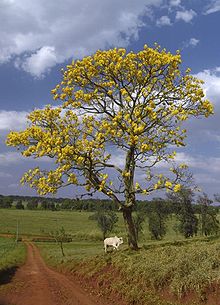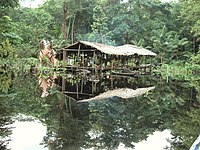This is an old revision of this page, as edited by 209.12.151.110 (talk) at 15:32, 27 August 2009. The present address (URL) is a permanent link to this revision, which may differ significantly from the current revision.
Revision as of 15:32, 27 August 2009 by 209.12.151.110 (talk)(diff) ← Previous revision | Latest revision (diff) | Newer revision → (diff)Venezuela has a total of 150 plants for sewage treatment. However still 13% percent of the population lack access to drinking water but this number seems to be dropping.
Travelers to Venezuela are advised to obtain vaccinations for a variety of diseases including typhoid, yellow fever, cholera, hepatitis A, hepatitis B and hepatitis D. In a cholera epidemic of contemporary times in the Orinoco Delta, Venezuela's political leaders were accused of racial profiling of their own indigenous people to deflect blame from the country's institutions, thereby aggravating the epidemic.
Venezuela has a national universal health care system that Sucks big time!! %20for%20All.htm |accessdate=2008-01-18}}</ref>
Foreign relations
Main article: Foreign relations of VenezuelaThroughout most of the 20th century, Venezuela maintained friendly relations with most Latin American and Western nations. Relations between Venezuela and the United States government worsened in 2002, after the 2002 Venezuelan coup d'état attempt during which the U.S. government recognized the short-lived interim presidency of Pedro Carmona. Correspondingly, ties to various Latin American and Middle Eastern countries not allied to the U.S. have strengthened. Venezuela seeks alternative hemispheric integration via such proposals as the Bolivarian Alternative for the Americas trade proposal and the newly launched pan-Latin American television network teleSUR. The Venezuelan government has also expressed its support for the Russian position on the International recognition of Abkhazia and South Ossetia, which United States and its allies strongly oppose. Venezuela was a proponent of OAS's decision to adopt its Anti-Corruption Convention, and is actively working in the Mercosur trade bloc to push increased trade and energy integration. Globally, it seeks a "multi-polar" world based on strengthened ties among Third World countries.
Military
See also: Military of VenezuelaVenezuela's national armed forces include roughly 100,000 personnel spread through four service branches: the Ground Forces, the Navy of Venezuela Navy (including the Marine Corps), the Air Force, and the Armed Forces of Cooperation (FAC), commonly known as the National Guard. As of 2008, a further 600,000 soldiers were incorporated into a new branch, known as the Armed Reserve. The President of Venezuela is the commander-in-chief of the national armed forces.
Animals and plants
Main articles: Fauna of Venezuela, Flora of Venezuela, National symbols of Venezuela, and List of birds of Venezuela
Venezuela lies within the Neotropic ecozone; large portions of the country were originally covered by moist broadleaf forests. One of seventeen megadiverse countries and among the top twenty countries in terms of endemism, some 38% of the over 21,000 plant species are unique to the country; 23% of reptilian and 50% of amphibian species are also endemic. Venezuela hosts significant biodiversity across habitats ranging from xeric scrublands in the extreme northwest to coastal mangrove forests in the northeast. Its cloud forests and lowland rainforests are particularly rich, for example hosting over 25,000 species of orchids. These include the flor de mayo orchid (Cattleya mossiae), the national flower.

Venezuela's national tree is the araguaney, whose characteristic lushness after the rainy season led novelist Rómulo Gallegos to name it «a primavera de oro de los araguaneyes» ("the golden spring of the araguaneyes"). Notable mammals include the giant anteater, jaguar, and the capybara, the world's largest rodent. More than half of Venezuelan avian and mammalian species are found in the Amazonian forests south of the Orinoco. Manatees, Boto river dolphins, and Orinoco crocodiles, which have been reported to reach up to 6.6 metres (22 ft) in length, are notable aquatic species. Venezuela hosts a total of 1,417 bird species, 48 of which are endemic. Important birds include ibises, ospreys, kingfishers,Template:Inote and the yellow-orange turpial, the national bird.
In recent decades, logging, mining, shifting cultivation, development, and other human activities have posed a major threat to Venezuela's wildlife; between 1990 and 2000, 0.40% of forest cover was cleared annually. In response, federal protections for critical habitat were implemented; for example, 20% to 33% of forested land is protected. Venezuela is currently home to a biosphere reserve that is part of the World Network of Biosphere Reserves; five wetlands are registered under the Ramsar Convention. In 2003, 70% of the nation's land was under conservation management in over 200 protected areas, including 43 national parks.
-
 La Galera beach in Margarita Island
La Galera beach in Margarita Island
-
 Angel Falls, the tallest waterfall in the world
Angel Falls, the tallest waterfall in the world
-
 Playa Medina, Estado Sucre
Playa Medina, Estado Sucre
-
 Venezuelan Coastal Range
Venezuelan Coastal Range
-
 Canaima National Park has Precambrian geological formations that rank among the world's oldest.
Canaima National Park has Precambrian geological formations that rank among the world's oldest.
-
 Los Llanos
Los Llanos
-
The countryside in Mérida
Culture
Main articles: Culture of Venezuela, Heritage of Venezuela, and Music of Venezuela


Venezuela's heritage, art, and culture have been heavily influenced by the Caribbean context. These elements extend to its historic buildings, architecture, art, landscape, boundaries, and monuments. Venezuelan culture has been shaped by indigenous, Spanish and African influences. Before this period, indigenous culture was expressed in art (petroglyphs), crafts, architecture (shabonos), and social organization. Aboriginal culture was subsequently assimilated by Spaniards; over the years, the hybrid culture had diversified by region.
Venezuelan art was initially dominated by religious motifs but began emphasizing historical and heroic representations in the late 19th century, a move led by Martín Tovar y Tovar. Modernism took over in the 20th century. Notable Venezuelan artists include Arturo Michelena, Cristóbal Rojas, Armando Reverón, Manuel Cabré; the kinetic artists Jesús-Rafael Soto and Carlos Cruz-Diez; and contemporary artist Yucef Merhi.
Venezuelan literature originated soon after the Spanish conquest of the mostly pre-literate indigenous societies; it was dominated by Spanish influences. Following the rise of political literature during the War of Independence, Venezuelan Romanticism, notably expounded by Juan Vicente González, emerged as the first important genre in the region. Although mainly focused on narrative writing, Venezuelan literature was advanced by poets such as Andrés Eloy Blanco and Fermín Toro. Major writers and novelists include Rómulo Gallegos, Teresa de la Parra, Arturo Uslar Pietri, Adriano González León, Miguel Otero Silva, and Mariano Picón Salas. The great poet and humanist Andrés Bello was also an educator and intellectual. Others, such as Laureano Vallenilla Lanz and José Gil Fortoul, contributed to Venezuelan Positivism.
Carlos Raúl Villanueva was the most important Venezuelan architect of the modern era; he designed the Central University of Venezuela, (a World Heritage Site) and its Aula Magna. Other notable architectural works include the Capitolio, the Baralt Theatre, the Teresa Carreño Cultural Complex, and the General Rafael Urdaneta Bridge.

Indigenous musical styles of Venezuela are exemplified by the groups Un Solo Pueblo and Serenata Guayanesa. The national musical instrument is the cuatro. Typical musical styles and pieces mainly emerged in and around the llanos region, including Alma Llanera (by Pedro Elías Gutiérrez and Rafael Bolivar Coronado), Florentino y el Diablo (by Alberto Arvelo Torrealba), Concierto en la Llanura by Juan Vicente Torrealba, and Caballo Viejo (by Simón Díaz). The Zulian gaita is also a popular style, generally performed during Christmas. The national dance is the joropo. Teresa Carreño was a world-famous 19th century piano virtuosa. In the last years, Classical Music has had great performances. The Simon Bolivar Youth Orchestra has realized excellent presentations in many European concert halls, notably at the 2007 Proms, and has received honors of the public.
Baseball is Venezuela's most popular sport, although football (soccer), spearheaded by the Venezuela national football team, is gaining influence.
Venezuela is well-known for its successions in beauty pageants. Miss Venezuela is a big event in the country, and Venezuela has received 5 Miss World, 6 Miss Universe and 5 Miss International titles.
The World Values Survey has consistently shown Venezuelans to be among the happiest people in the world, with 55% of those questioned saying they were "very happy".
Etymology

The name "Venezuela" is believed to have originated from Amerigo Vespucci who, along with Alonso de Ojeda, led a 1499 naval expedition along the northwestern coast's Gulf of Venezuela. On reaching the Guajira Peninsula, the crew observed villages (palafitos) that the people had built over the water. This reminded Vespucci of the city of Venice (Template:Lang-it), so he named the region "Venezuola", meaning "little Venice" in Italian. In Spanish, the suffix -zuela is used as a diminutive term (e.g., plaza / plazuela, cazo / cazuela); thus, the term's original sense would have been that of a "little Venice".
Martín Fernández de Enciso, a member of the Vespucci and Ojeda's crew, states in his work Summa de Geografía that the indigenous population they found were called "Veneciuela", suggesting that the name "Venezuela" may have evolved from a native word. The Vespucci story, however, remains the most popular and accepted version of the origin of the country's name.
See also
Main article: Outline of VenezuelaReferences
- http://www.gobiernoenlinea.ve/misc-view/sharedfiles/Metas_Milenio.pdf (Page 65)
- Venezuela Guardian. Accessed September 20, 2006.
- Stories in the Time of Cholera by Charles L. Briggs
- Castro, Arachu (2008). "Barrio adentro a look at the origins of a social mission". David Rockefeller Center for Latin American Studies, Harvard University. Retrieved 29 January 2009.
{{cite web}}: Italic or bold markup not allowed in:|publisher=(help); Unknown parameter|dateformat=ignored (help) - ^ "Venezuela: Overview". Global Forest Watch. Retrieved 2007-03-10..
- Cite error: The named reference
LOC_2005was invoked but never defined (see the help page). - Dydynski & Beech 2004, p. 42
- ^ Template:Harvard reference.
- Lepage, Denis. "Checklist of birds of Venezuela". Bird Checklists of the World. Avibase. Retrieved 2007-05-04.
{{cite web}}: Cite has empty unknown parameter:|coauthors=(help) - Peck, D (2000). "The Annotated Ramsar List of Wetlands of International Importance: Venezuela". The Ramsar Convention on Wetlands. Ramsar Convention Secretariat. Retrieved 2007-03-10.
- "Biodiversity and Protected Areas—Venezuela" (PDF). EarthTrends Country Profiles. World Resources Institute. 2003. Retrieved 2007-03-10.
- "Coro and its Port". UNESCO World Heritage Centre. 1993.
- "Ciudad Universitaria de Caracas". UNESCO World Heritage Centre. 2000.
- "Happiness Statistics By Country". Nationmaster.com. Retrieved 2007-06-21.
- Template:Harvard reference. p. 177.
- Thomas, Hugh (2005). Rivers of Gold: The Rise of the Spanish Empire, from Columbus to Magellan. Random House. p. 189. ISBN 0-37550-204-1.
- "Cuadernos Hispanoamericanos" (in Spanish). Instituto de Cultura Hispánica (Agencia Española de Cooperación Internacional). 1958: 386.
{{cite journal}}: Cite journal requires|journal=(help)
External links
- E-Government (in Spanish)
- Template:Wikitravel
- "Venezuela". The World Factbook (2025 ed.). Central Intelligence Agency.
- Venezuela at UCB Libraries GovPubs
- Template:Dmoz
- Venezuela at Encyclopædia Britannica
- Venezuela from the Library of Congress Country Studies (1990)
- Venezuela Information Office
| |||||||||||
| International membership | |||||||||||||||||||||||||||||||||||||||||||||||||
|---|---|---|---|---|---|---|---|---|---|---|---|---|---|---|---|---|---|---|---|---|---|---|---|---|---|---|---|---|---|---|---|---|---|---|---|---|---|---|---|---|---|---|---|---|---|---|---|---|---|
|
Template:Latin Union Template:Union of South American Nations (Unasur\Unasul)
Template:Mercosur\Mercosul (Southern Common Market)
| |||||||||||||||||||||||||||||||||||||||||||||||||
